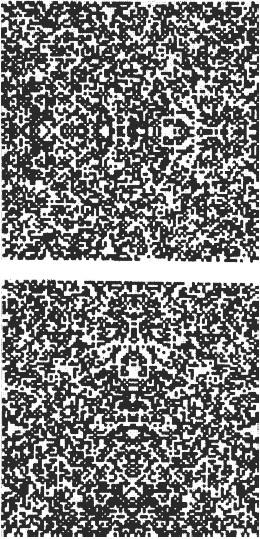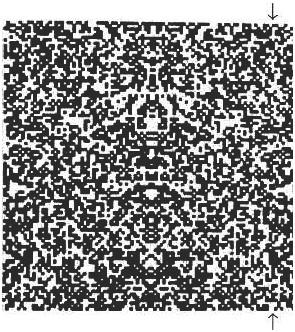The Puzzle of Left-Handedness (12 page)

16
Why a Running Rabbit Doesn’t Tear
Itself Apart
Although it’s harder for us to tell left from right than, for example, top from bottom, we can recognize mirror-image likenesses between left and right much more easily than other symmetries. That’s only logical. Your life may depend on it, whereas in emergencies chance symmetries between top and bottom or front and back are merely a distraction. What happens off to our left requires a reaction that’s a neat reversal of the way we react to precisely the same event to our right, whereas what happens in front of us demands a totally different reaction from what happens behind us.
Our sensitivity to left–right symmetry is clearly visible in the things we make. Traditionally, cathedrals and other large, official buildings are symmetrical when seen from the front, just as we are, but when looked at from the side there’s no symmetry between the front and back halves. Such buildings, intended to be seen mainly from the front, have to radiate certainty and authority. The sense of repose evoked in us by symmetry helps them to achieve this. The same does not apply to fairytale castles, which, from Neuschwanstein in Bavaria to the Queen’s castle in the Walt Disney film
Snow White and the Seven Dwarfs
(1937), are intended to create romantic tension, an enjoyable sense of mystery and adventure. They are therefore anything but symmetrical.
Friezes and decorative paintings often feature some form of left– right symmetry, but only rarely do we see a mirroring of top and bottom, the way riverbanks are reflected in the water. Clearly we are particularly sensitive to left–right symmetry, but how we detect it is another question, one we can answer only in part.
By and large our visual system consists of the retina deep within each eye, the visual cortex and the optic nerve that connects the two. The visual cortex is at the back of the brain, so although we look with our eyes, we see with the backs of our heads. The eyes appear to be connected crossways to the left and right halves of the visual cortex, in the same way that many other body parts are controlled by the opposite half of the brain, but it only seems that way. In reality the system is more refined: the right half of the brain processes information coming from the left half of the field of vision, which falls on the right half of the retina of each eye, while the left half of the brain deals with information from the left half of each retina, which comes from the right half of the visual field. The result is that the right half of the brain processes everything that happens on the left side of whatever we’re looking at, and vice versa.
| At first sight the lower of these two patterns by Bela Julesz looks symmetrical, the other asymmetrical. In fact they are the same, except that one is perpendicular to the other. If you turn this book through 90 degrees, the symmetry will move to the other pattern. We immediately notice left–right symmetry but are less likely to spot top–bottom symmetry. |  |

Neuschwanstein, the fairytale castle built by the romantic but shy King Ludwig ii of Bavaria in the second half of the nineteenth century in ‘the genuine style of the old German knightly fortresses’, as he wrote to Richard Wagner, ‘with the winds of heaven blowing around it’.
This may strike us as an unnecessarily complicated way of going about things, but the evolutionary advantage it confers is easy to recognize. Eyes have to be exposed to the outside world, otherwise they would see nothing, but this makes them more vulnerable than the brain, which is stored safely away in the skull. The layout of our visual system ensures that even if one eye is put out of action completely, we can still use our entire visual cortex, since each eye serves both halves of the brain. A one-eyed person has a larger blind angle than normal and can no longer see depth – this applies only to the handful of species that have two eyes facing forwards – but in all other respects their visual faculties remain just as good as anyone else’s. Were both eyes connected in their entirety to one cerebral hemisphere or the other, the loss of one eye would partially or entirely disable half our visual brain capacity.
All mammals have the same mishap-resistant set-up, but not all vertebrates. Pigeons, for example, have a system in which each eye is connected exclusively with one half of the brain.
This raises the question of how our visual system manages to recognize left–right symmetry. We cannot say for certain. A number of suggestions have been made, the most credible being an idea put forward by Bela Julesz, a researcher at Bell Laboratories in America, in about 1970. His theory, which builds on earlier work by the Austrian physicist and philosopher Ernst Mach, goes roughly as follows.
The visual cortex of each cerebral hemisphere includes among other things an area in which information coming from the eye is ‘pictured’ before being processed further. We will call this area the projection screen, even though that’s a misleading term in some ways, since of course no one is actually looking. To put it rather simplistically, the stimulation of the projection screen area by signals from the retina is the first phase of the process we call seeing.
| The visual system, in broad outline. Light entering from the left of the visual field travels to the right side of the retina in both eyes, and from there signals travel to the right side of the primary visual cortex at the back of the head. |  |
If we look at the centre of a shape that has left–right symmetry, then one half of it is pictured by both eyes in the left side of the visual cortex and the other half in the right side. To recognize symmetry we have to compare every point on the left half of the projection screen with its corresponding point on the right. This is made possible by the
corpus
callosum
, a broad bundle of some 150 million axons that connects the two halves of the brain. If almost all the points we compare are stimulated in the same way, then we know we’re looking at something symmetrical.
Julesz produced symmetrical patterns that provide quite strong evidence that the detection of symmetry does indeed essentially work this way. If, after identifying symmetry, we then focus not on the middle of the pattern but on some other point to the left or right, we are suddenly unable to see the symmetry any longer. What’s left is an unstructured jumble of black and white squares.
It seems a sound argument, but there is one serious snag. How come we’re capable of making comparisons of this kind? The answer is by no means obvious.
 | The same symmetrical Julesz pattern as before. If we focus on an imaginary line between the two arrows, we suddenly cease to see any symmetry. |
Seeing is an involuntary process, which cannot be switched off even if we deprive ourselves of sight by shutting our eyes. Anyone who has ever sunbathed on a beach knows that we can’t ignore the light that penetrates our eyelids. Everything that gets through to our eyes from whatever is happening in front of us is sent to the visual cortex, which puts together as coherent an image as possible, whether we want it to or not. This is not to say that we are conscious of everything we see. On the contrary, most of the signals that reach us are dismissed as unimportant after passing through an initial stage in the process. Sometimes they get stored away in the memory, but often they are immediately forgotten.
The degree of relentless diligence the visual cortex exhibits in processing images at lightning speed all day long without our noticing is demonstrated by the reflex reactions we are capable of having to things in our visual field. A fly or a drop of fat from a frying pan heading straight for an eye makes us close the eyelid with remarkable speed. If we notice it at all, it’s not until afterwards. We would never be able to react consciously as quickly as that. Everyone knows the feeling of having seen ‘something’ but not being able to say quite what it was. It’s a popu lar feature of detective novels.
Seeing consists of a great deal more than simply the depicting of im pulses on the projection screens of the primary visual cortex. It’s impor tant to remember that on each projection screen, images from each eye relate to only one half of the field of vision. First the data from both eyes has to be compared and combined, so that a coherent half-image is created (one that has depth as a result of the slight difference in the angle of vision between the two eyes). Then those two half-images have to be linked together into the one, seamless, complete image that we experience.
Seeing symmetry is as involuntary as the act of seeing itself, so it’s reasonable to assume it’s an integral part of the process of comparison and splicing together of half-images. In other words it’s apparently here that mirroring enters into the process in some way. But this presents a significant problem, since everything suggests that we do not use mirroring in interpreting signals coming from the retina. If we did, we’d become severely disorientated. It would be like living in a crazy fair-ground attraction.
Imagine what would happen if the splicing together of the two half-images, in other words the integration of images in the two halves of the brain, involved mirroring. A rabbit running past would appear to run back towards where it came from as soon as it passed the centre of our field of vision. This is clearly not the way it works. If it were, not only would we hardly ever catch any rabbits, but we’d also be terribly accident-prone. It’s even less likely that the mirroring takes place as we compare versions of the same half-image from our left and right eyes, in other words within one and the same cerebral hemisphere. If it did, then a rabbit that according to our left eye was running from left to right would be running in precisely the opposite direction according to our right eye. This would also make it completely impossible for us to detect symmetry, since after mirroring, none of the points in the image from one eye would coincide with its counterpart in the image from the other eye. Seeing depth, a capacity that relies on slight differences in position of the same impulse on the two retinas, would be impossible as well.
